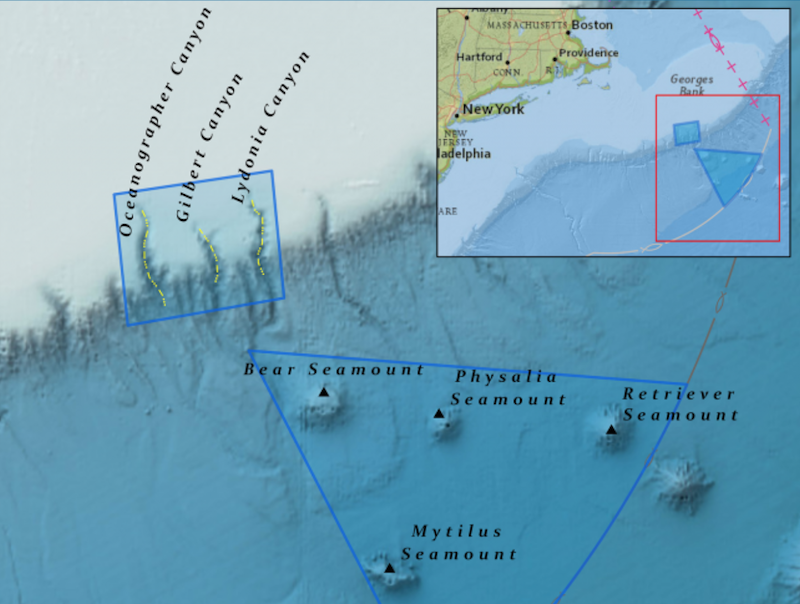In another reversal of Trump administration moves, President Biden on Friday reinstated all restrictions to the Northeast Canyons and Seamounts Marine National Monument, including plans to phase out commercial fishing for red crab and lobster by Sept. 15, 2023.
Former president Barack Obama originally declared the monument area south of New England on that date in 2016, and former president Donald Trump rescinded the rules with some fanfare including an in-person meeting with fishing industry representatives in June 2020.
Environmental groups that had pushed Obama for the monument lobbied hard after Biden’s inauguration to flip that Trump order 180 degrees, along with reversing Trump’s reductions of the Bears Ears and Grand Staircase-Escalante national monuments in Utah.
Late Thursday they got word their wish was granted.
Commercial fishing advocates, who mobilized after Biden inauguration to argue against reinstating the monument rules, said the decision shows politics trumped consistent ocean policy.
“This is an unfortunate decision that is opposed not only by those affected in the commercial fishing industry, but by all eight fishery management councils and NOAA Fisheries,” said Bob Vanasse of Saving Seafood, an industry advocacy group. “There is no scientific justification to prohibit commercial fishing while allowing recreational fishing. While the Biden-Harris Administration has claimed decisions will be based on science, and not on who has the stronger lobby, this decision shows otherwise."
In a media advisory about the 2:30 p.m. proclamation signing ceremony, White House officials cast the move as a continuation of efforts to renew protections for natural resources – including other fisheries.
“The Administration has halted leasing in the Arctic National Wildlife Refuge, committed to restore protections for the Tongass National Forest under the Roadless Rule, and initiated the process to protect Bristol Bay and the world-class salmon fishery it supports. The Great Lakes, the Chesapeake Bay, the Everglades, the Columbia River Basin, and dozens of other special places are also back on America’s conservation agenda."
The Northeast marine monument includes Oceanographer, Gilbert, and Lydonia canyons; and Bear, Mytilus, Physalia, and Retriever seamounts, some 4,913 square miles in all – about equal to the land mass of Connecticut.
“Restoring the Monument’s conditions will restore its integrity, expand the opportunity for unique scientific study and exploration, and protect and preserve natural and cultural resources for all Americans,” according to the White House statement.
While recreational fishing can continue in the monument area, crab, lobster and longline fishermen say excluding them is an unjustified end-run around the federal and council management process.
“In March, before (Interior) Secretary Haaland was confirmed, industry members were given just one hour with staff to express their concerns. We have since requested an opportunity to meet with the Secretary — as we did with her two predecessors — but our request, though acknowledged has gone unanswered,” according to Vannasse.
“Anyone who likes fresh local swordfish, tuna, lobster and crabmeat should be very angry with the Harris-Biden Administration today. And I know some environmental advocates will claim that the statistics show that no harm has been done to the fisheries from this closure,” said Vanasse. “They think that because they don’t understand fisheries and misunderstand the statistics. We could have explained that to Secretary Haaland if she had bothered to listen.
“The Mid-Atlantic and New England Fishery Management Councils have already done their job, and have protected the deep-sea corals in the region with public input using their authority under the Magnuson-Stevens Act. Marine sanctuaries should be created with public input as outlined in the National Marine Sanctuaries Act, not by the stroke of the Presidential pen via a misuse of the Antiquities Act.”
Environmental groups praised the announcement.
“This is an extremely important moment for all who care about protecting the ocean,” said Steve Coan, president and CEO of the Mystic Aquarium in Connecticut, where scientists there and at the New England Aquarium collaborated on research supporting the 3.14 million acre monument designation. “The monument provides a great opportunity for our scientists to study this spectacular ‘living laboratory’ and better understand how the ocean works.”
Monument critics, however, have staked some hope on an unusual March 22 statement from Supreme Court Chief Justice John Roberts, expressing his doubts that applying the Antiquities Act to the seafloor is a logical extension of that presidential power.
That could be a road map for an argument challenging the Northeast monument before the high court, they suggest.
“Now all we can do is hope that the full Supreme Court takes heed of Chief Justice Roberts’ who recently expressed concern that presidents have been exercising ‘power without any discernible limit’ when they create new national monuments,” said Vanasse.







